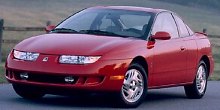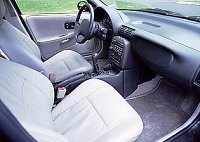The first cars, SL sedan and its coupe version SC, went into production in the new Tennessee factory in 1990. The pair was renowned for radical idea for GM's standard - plastic body panel, all-independent suspensions and GM's second-ever 4-valve-per-cylinder engine (the first one was Quad4). While performance and handling were up to the world standards, however, lack of attention to detail and poor refinement prevent it from really challenging the Japanese duo. Sales in the America was just sufficient to keep the factory operating, while overseas sales - it was once promoted in Japan, due to political correctness perhaps - was so disappointing that could be ignored. In around 96 to 97, the pair received a big makeover. The basic floorpan was basically unchanged, but the whole body was rebuilt to improve stiffness and quietness. The notorious, harsh 4-cylinder engine was revised to reduce NVH a bit. That is the car you see today. However, in 1999 there were again tweaks to the still-harsh engine, that is, added 4 more counter weights to the crankshaft. Witnessing the vast reduction of vibration and noise as a result, now we know why the original engine as well as the first revision were so harsh : because they had only 4 counter weights ! That was quite outdated by industrial norm. In engineering view point, a pair of counter weights is required to achieve the best balance for a single cylinder, so a four pot engine needs 8 pieces of counter weights. How much does they cost ? not much. But the missing 4 pieces had already cost Saturn's reputation ! A lesson was learned. The 1.9-litre four, no matter in dohc 16-valve form or sohc 8-valve form, no longer receives complaint. However, saying it a good match for the Japanese engines is not true. It is still not as smooth and as quiet. Bottom-end and mid-range torque are also not very impressive. Luckily, the car is light enough to give a brisk performance in the 16-valve form, which has 124-horsepower on tap.
Even excluding the European Car of the Year 1999 from the lists, Saturn still fails to topple the Civic and Corolla in sales chart, because, again, it paid less attention to detail. The interior is not only dull to look at but also too simple, too cheap. Then, it does not ride as well as others. If there are any
advantages
to the Saturn, the first one must be the unique body structure - steel
space frame enclosed with dent-resisting polymer (plastic, in other
words)
panels. Only the roof, bonnet and boot lid are made of metal.
Strangely,
Saturn's owners always proud of this (for what ? why do other 99.9%
drivers
favour conventional steel body ?). The second advantage is limited to
the
SC coupe : it has become the world's first 3-door coupe. Not a
hatchback
of course, it's a reverse-hinged side door for the rear passengers for
easier access. The concept is not really clever, but at least it makes
the Saturn coupe unique. |
||
| The above report was last updated on 1 Jan 2000. All Rights Reserved. |


 There
is trade-off to the lightweight : the chassis feels not as solid as
others,
especially the best car around, Ford Focus. It requires a
stiffer-than-normal
suspension setting to achieve a lively handling. Compare with the
Focus,
now available in the US at the same price range, the Saturn LS2
suddenly
became second class. Focus not only handles better (far better indeed),
but also offers bigger interior room, classier styling and packaging no
matter inside or outside. It rides significantly smoother too. Perhaps
GM had never think that the biggest threat to the Saturn would come
from
old rival Ford.
There
is trade-off to the lightweight : the chassis feels not as solid as
others,
especially the best car around, Ford Focus. It requires a
stiffer-than-normal
suspension setting to achieve a lively handling. Compare with the
Focus,
now available in the US at the same price range, the Saturn LS2
suddenly
became second class. Focus not only handles better (far better indeed),
but also offers bigger interior room, classier styling and packaging no
matter inside or outside. It rides significantly smoother too. Perhaps
GM had never think that the biggest threat to the Saturn would come
from
old rival Ford.